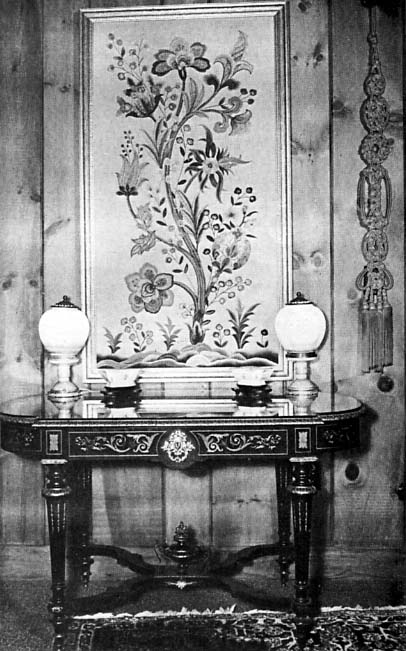By Marilyn Hackett Moulton
Photography by Peter E. Randall
New Hampshire Profiles, February 1970
Vol. XIX – No. 2 – Pg. 36

When Chester Grady purchased a one-room beach cottage some thirty years ago for use as a hideaway, even he did not imagine that it would become the nucleus for a home filled with the choice possessions and memorabilia of a man who is a citizen of the world, but a legal resident of Hampton.
Mr. Grady was born in Lakeport, New Hampshire, and as a youth, worked as a waiter at Hampton Beach. It was natural for him to return to this locale in his quest for a summer residence away from New York City where he was, at that time, associated with NBC radio. In partnership with two others, Chester bought the former Palmer boarding house where judge Henry Shute wrote, “The Real Diary of a Real Boy.”
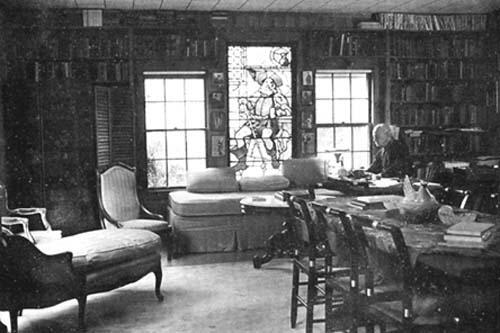
Situated near the North Shore end of Hampton Beach, the property consisted of a 22-room house, a barn, ice house and surrounding acreage. It was re-named the “Craymore” by its new owners.
Since the boarding house tradition was continued at the Craymore, Chester decided on the purchase of a beach cottage, offered for sale by the Hampton Beach Coast Guard at a price of $60, for use as a private retreat. It was moved to a spot near the pond at the rear of the Craymore. A sunbathing patio was added and from then on, over a period of years, the little cottage grew like “Topsy.”

The Confucius sitting atop the
teakwood table is enamel on
copper and was especially
purchased for the Gradys
by John Wannamaker.
The first major addition, bought at auction, was the Little Boar’s Head Post Office and it now serves as the formal dining room. The Craymore ice house was “appropriated” for conversion into the master bedroom. By building in and around the three original units, ice house, post office and beach cottage, Grady obtained two bathrooms, a kitchen and an eating area. Later, the sunbathing patio was enclosed to create the dropped living room.
About the time Chester married his late wife, Rae, the Hampton hideaway became a year ’round residence. With the addition of some of Mrs. Grady’s furnishings, including the discovery that between them, the Gradys were the proud possessors of eight pressure cookers, space was of the essence. A building separate from the main house was constructed for use primarily as a work and entertainment area and it is here in the studio where Grady spends much of his time in preparing for lectures and writing papers in conjunction with his work with the American Society of Psychical Research (see New Hampshire PROFILES, August ’65). He has spent several decades in ESP research both here and abroad. Currently Chester is working on his memoirs.
The magnificent crewel work in the dining room is another example of this unusual gentleman’s talent. The design is a museum copy but the subtle tones are individually created. The pine paneling and beamed ceiling is also Grady workmanship, although he has no illusions about being a craftsman in the same category as his father who was a master cabinetmaker.
The floor, where summer residents once stood to get their mail, is now covered by a Royal Sarouk rug and the stamp booths have been replaced with an Italian handcarved walnut dining room set with velvet covered chairs.
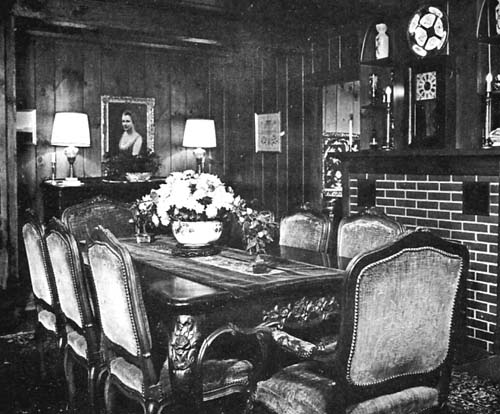
The shuttered closet to the right of the fireplace was originally a window, but rather than board it up or have it open into the living room, the shuttered effect remains. Shelves house what Chester refers to as “family remnants” including pieces of Copper Luster, Chelsea, Venetian glass, Staffordshire, Bristol and some cups dating back at least 150 years. The more unusual pieces include a pair of ornamental trees of semi-precious stones with jade leaves.
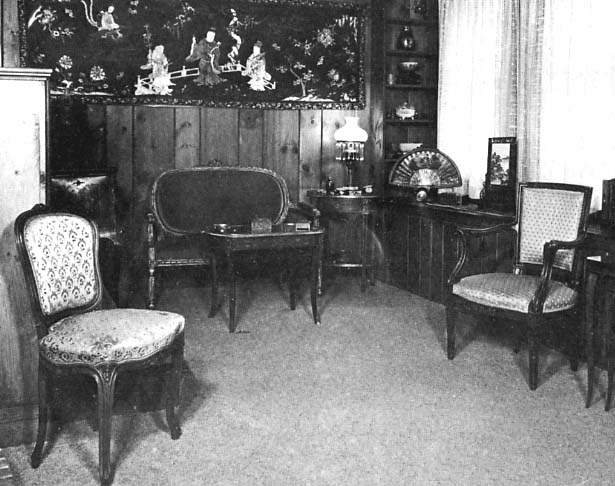
.The step-down living room overlooks the pond and woodsy landscape. Its paneling and soft green broadloom are a perfect backdrop for the striking teakwood furnishings and collection of oriental art objects. At the further end of the room is an authentic hand-carved and gilded opium bed with Chinese red mattress. Above are four gilt framed Chinese silk tapestries and a silk scroll which tells a story in the same manner as an oriental rug. The marble topped teakwood table in front of the bed and the teak chairs are originally from the Summer Palace of Old Buddha, once the home of the Empress of China. At the opposite end of the room is an exceptionally well preserved French tapestry flanked by pair of girandoles with their original wooden replica candles.
Representative of the Ming Period (1384-1644) are two pairs of Grave Horses, an ancestral moss jade tablet and a pair of Chinese white jade scepters — the symbol of authority — encased in teak and glass. Other pieces of note in the living room include a French marble topped liquor cabinet that opens on all four sides and assorted chairs and tables from the Louis XIV and XV periods. A hand-painted inlaid pearl fan from Spain, decorated on both sides, was a gift to Mrs. Grady. Tucked in corners and displayed here and there are a variety of interesting objects: A Bohemian punch bowl and tray, a pair of Cornelian vases carved from one piece with semi-precious stones, Dresden sconces and an authentic Napoleonic odd box and ashtray. Mr. Grady is knowledgeable about the history and legends surrounding each of his treasures.
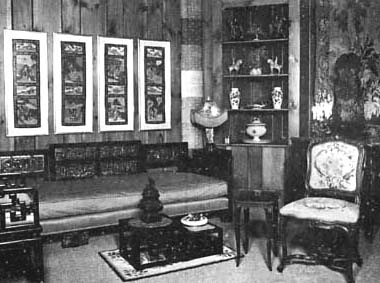
The hallway from the living room leads to guest bedrooms and a bath. In the larger twin bedded room, shades of gold predominate in both the velour carpeting and the toille curtains and matching headboard covers. A poudre dress table inlaid with marquetry and framed crewel work peacocks over the beds add interest to the room. Here, as throughout the house, various pieces of original art work are displayed. Numbered among them is a Grady “primitive.”
An Italian hand-carved bed is the focal point in the small paneled guest room. A teakwood desk, chair and mirror ensemble and a French slipper chair complete the furnishings. Of note is the pastel cherub by Barocchio.
The cherry paneled master bed room and bath are located at the opposite end of the house from the west wing. This bedroom was recently enlarged to accommodate a particularly handsome Chinese sculptured rug done in beige with pastel flowers. The bedroom furniture is French in origin. The gold velour of the bedspread and matching headboard combine with the velvet brocaded wing chair to add richness to the decor. Currier and Ives prints depicting the Battle of Waterloo are originals. One whole wall is devoted to closet space while another has sliding glass doors with a view to a small pond.
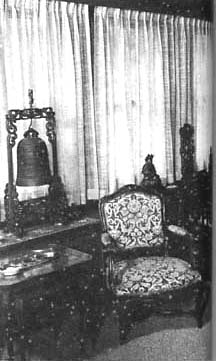
Running the length of the living
room wall is a shelf with
storage cupboards below.
Various art objects are displayed
including the large Chinese
bronze temple bell hanging from
a teakwood stand.
Efficiency rather than spaciousness is the keynote in the kitchen. Coppertone cupboards and appliances are accented by the yellow of the tile and counter tops. Avocado green carpets the floor. An accomplished cook, Grady said that some day he may write a “twist of the wrist” cookbook, filled with his own recipes gathered in part from years of sampling gourmet cuisine around the world and created in part by “throwing in this or that from the ice-box.”
The 20 by 30 foot structure in front of the house is known by Chester’s numerous Hampton friends as “the studio.” Whenever the local Kiwanis Club, of which Chester is a past president, wishes to hold an informal party, or local actors need a place to rehearse, “the studio” is always made available.
A refectory table surrounded by eight Hitchcock chairs centers the gold broadloom. Placed at random about the room are a pair of English Hall chairs, two fiddleback Victorian chairs and other assorted furniture. A Franklin stove gives the warm touch of Americana. Cocoa drapes hang at the large paned windows. The walls are covered with autographed photographs and letters from friends and personalities with whom Chester has either worked or been associated. As diversified as the fields of endeavor they represent, the photos include General MacArthur, Max Baer, Fred and Adele Astaire and Sir Arthur Conan Doyle.

In this age of specialization when home building is primarily dictated by architects and designers, it is unusual to find a home of discrimination that truly reflects the life and experience of its owner. Chester believes that “with a little ability and a little ingenuity, one can create something from nothing.” He has done just that with his home, and it is pure “Grady.”
